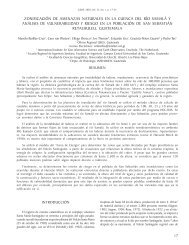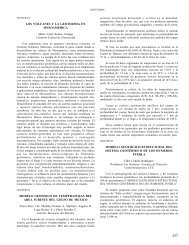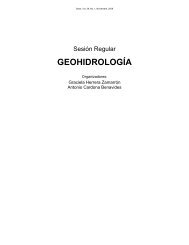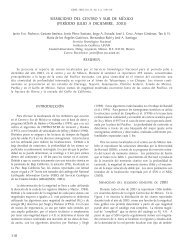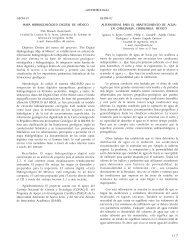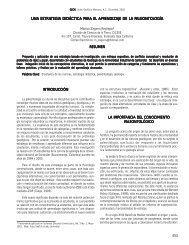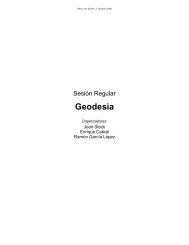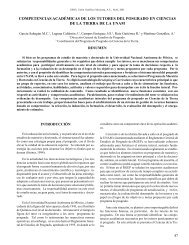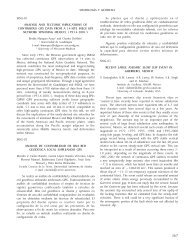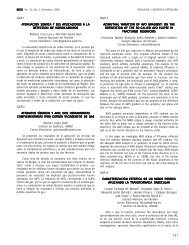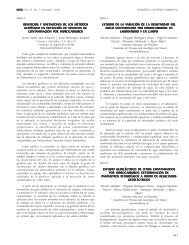Libro de Resúmenes - Unión Geofisica Mexicana AC
Libro de Resúmenes - Unión Geofisica Mexicana AC
Libro de Resúmenes - Unión Geofisica Mexicana AC
Create successful ePaper yourself
Turn your PDF publications into a flip-book with our unique Google optimized e-Paper software.
VULCANOLOGÍA Geos, Vol. 30, No. 1, Noviembre, 2010<br />
VUL-1<br />
ASPECTOS DE VULCANOLOGÍA FÍSICA SOBRE LAS<br />
IGNIMBRITAS HIPERALCALINAS DEL MIOCENO MEDIO EN<br />
EL NW DE MÉXICO: IMPLIC<strong>AC</strong>IONES PALEOTOPOGRÁFICAS<br />
Pacheco Hoyos Jaime Gabriel 1 , Vidal Solano Jesús Roberto 1 y Stock Joann 2<br />
1 Departamento <strong>de</strong> Geología, Universidad <strong>de</strong> Sonora<br />
2 Seismological Laboratory, California Institute of Technology<br />
jaimegab.pachecohoy@correoa.uson.mx<br />
Las ignimbritas Hiperalcalinas <strong>de</strong>l NW <strong>de</strong> México (Vidal-Solano et al., 2005<br />
CRAS, 2007 RMCG; 2008 BSGF), forman parte <strong>de</strong> un peculiar evento volcánico<br />
registrado durante el Mioceno Medio. Este episodio es caracterizado por la<br />
erupción <strong>de</strong> lavas con un alto contenido en sílice (>74%), relativamente altos<br />
contenidos <strong>de</strong> hierro y una alta proporción <strong>de</strong> álcalis (siendo mayor el K) con<br />
respecto a la alúmina. La mineralogía es dominada por una asociación anhidra<br />
<strong>de</strong> sanidina+fayalita (casi al 100%)+clinopiroxeno ver<strong>de</strong> rico en hierro. Dentro<br />
<strong>de</strong> estas ignimbritas bien constreñidas a un periodo corto entre los 11 y 12<br />
Ma, <strong>de</strong>staca una unidad <strong>de</strong> enfriamiento <strong>de</strong> gran magnitud y extensión, que<br />
ha sido reconocida tanto en Sonora, como en Baja California (La Toba <strong>de</strong> San<br />
Felipe, Stock et al., 1999 JVGR). Esta Ignimbrita, presenta como características<br />
vulcanológicas más importantes, un espesor, el cual, generalmente no supera<br />
los 100 metros, un alto grado <strong>de</strong> soldadura, la ocurrencia frecuente <strong>de</strong><br />
un vitrófiro en la base, y también la presencia <strong>de</strong> alteraciones amarillas y<br />
texturas perlíticas que han sido asociadas a su emplazamiento en sectores<br />
húmedos. En el presente trabajo, el estudio <strong>de</strong> esta unidad se basa, por un<br />
lado, en correlaciones <strong>de</strong> columnas levantadas en campo, <strong>de</strong> los diferentes<br />
afloramientos ignimbriticos que presentan una gran variedad <strong>de</strong> facies y, por<br />
otro lado, en el estudio <strong>de</strong> petrofábrica <strong>de</strong> las muestras <strong>de</strong> mano por medio <strong>de</strong>l<br />
uso <strong>de</strong> imágenes digitales (Cappaccioni et al 1996 JVGR, 1997 Bull Vulcanol,<br />
2001 JVGR y Pacheco-Hoyos et al., 2009 UGM). Este último estudio, está<br />
encaminado a la <strong>de</strong>terminación <strong>de</strong> la dirección y/o el sentido <strong>de</strong> los flujos<br />
piroclásticos hiperalcalinos, que permita enten<strong>de</strong>r la ubicación <strong>de</strong>l punto <strong>de</strong><br />
emisión y el escenario <strong>de</strong> su emplazamiento. Los resultados preliminares<br />
muestran que el emplazamiento <strong>de</strong> los flujos ignimbríticos no ocurrió sobre<br />
una topografía llana, sino que se vieron afectados por diferentes aspectos <strong>de</strong>l<br />
paleorelive, encausándolos en prolongados paleocanales, que los condujeron a<br />
su <strong>de</strong>pósito final en cuencas muy alejadas a su emanación. La ocurrencia <strong>de</strong> una<br />
amplia diversidad <strong>de</strong> unida<strong>de</strong>s geológicas bajo estos <strong>de</strong>pósitos ignimbriticos,<br />
tales como: a) ocurrencia <strong>de</strong> unida<strong>de</strong>s <strong>de</strong>l basamento ígneo-metamorfico <strong>de</strong>l<br />
Paleozoico y Laramídico, b) unida<strong>de</strong>s <strong>de</strong>rivadas <strong>de</strong>l arco volcánico continental<br />
Oligoceno-Mioceno y, c) <strong>de</strong>pósitos <strong>de</strong>tríticos asociados con una extensión tipo<br />
Basin and Range, muestra que en Sonora, al momento <strong>de</strong> la erupción <strong>de</strong><br />
las corriente piroclástica hiperalcalina, existía una fisiografía dominada por<br />
un arreglo en horst y graben, que pusieron al <strong>de</strong>scubierto todas las rocas<br />
mencionadas anteriormente. En conclusión, la integración <strong>de</strong> los resultados<br />
finales sobre el punto <strong>de</strong> emisión <strong>de</strong> los flujos, su distribución, el comportamiento<br />
<strong>de</strong> sus facies en el espacio y su correlación entre todos los afloramientos,<br />
ayudará a <strong>de</strong>scifrar si estos <strong>de</strong>pósitos han sido posteriormente <strong>de</strong>splazados,<br />
contribuyendo a los estudios <strong>de</strong> reconstrucción tectónica en el NW <strong>de</strong> México.<br />
VUL-2<br />
ESTUDIO FÍSICO Y QUÍMICO DEL VOLCANISMO FÉLSICO<br />
EN LA REGIÓN DE CATAVIÑA, BAJA CALIFORNIA:<br />
MANIFEST<strong>AC</strong>IONES OCCIDENTALES DEL GRAN DEPÓSITO<br />
IGNIMBRÍTICO HIPERALCALINO DEL NW DE MÉXICO<br />
Olguín Villa Angel Enrique 1 , Vidal Solano Jesús Roberto 1 y Stock Joann 2<br />
1 Departamento <strong>de</strong> Geología, Universidad <strong>de</strong> Sonora<br />
2 Seismological Laboratory, California Institute of Technology<br />
angele.olguinv@correoa.uson.mx<br />
Un volcanismo <strong>de</strong> tipo hiperalcalino ha sido reconocido <strong>de</strong>ntro <strong>de</strong> la<br />
secuencia <strong>de</strong>l Mioceno medio en la región <strong>de</strong> Cataviña, <strong>de</strong>ntro la península<br />
<strong>de</strong> Baja California. Este evento, a diferencia <strong>de</strong>l documentado en Sonora<br />
(Gómez-Valencia et al., 2010 Actas INAGEQ, Pacheco-Hoyos et al. y,<br />
Vidal-Solano et al, esta reunión), es solamente representado por la ocurrencia<br />
<strong>de</strong> manifestaciones piroclásticas soldadas <strong>de</strong> tipo ignimbrítico, mientras que<br />
en Sonora, se encuentra acompañado <strong>de</strong> riolitas fluidales (Barrera-Guerrero et<br />
al., 2010, actas INAGEQ). Sus <strong>de</strong>pósitos tienen un espesor reducido (aegirina>fayalita), que es idéntica<br />
a la encontrada en todos los vestigios <strong>de</strong> esta naturaleza en el NW <strong>de</strong> México,<br />
evi<strong>de</strong>ncia el carácter hiperalcalino <strong>de</strong> estas rocas. Los estudios químicos<br />
muestran, por un lado, que no existe ninguna relación genética entre la<br />
ignimbrita hiperalcalina y las capas volcanicas <strong>de</strong> la Formación Comondú<br />
que la subyace (an<strong>de</strong>sitas magnesianas y adakitas), por otro lado, que la<br />
presencia <strong>de</strong> enclaves <strong>de</strong> composición intermedia, encontradas en la Toba <strong>de</strong><br />
San Felipe y así como en Cataviña, correspon<strong>de</strong>n con traquitas comendíticas<br />
ligadas genéticamente a la Ignimbrita (Olguin-Villa et al., 2010 actas INAGEQ).<br />
Los estudios físicos, permiten establecer un mo<strong>de</strong>lo <strong>de</strong> emplazamiento para<br />
la ignimbrita hiperalcalina en la región <strong>de</strong> Cataviña. Este consi<strong>de</strong>ra, que la<br />
topografía tenía una vertiente general hacia el Pacífico, en un amplio valle,<br />
ayudando a este flujo piroclástico a dispersarse por la región <strong>de</strong> Cataviña. El<br />
flujo proveniente <strong>de</strong>l Oriente, arribó al área a través <strong>de</strong> paleo-canales existentes<br />
en un paleo-relieve que bor<strong>de</strong>aba el Este <strong>de</strong>l valle. Al llegar al valle, el flujo se<br />
esparció en un rango amplio <strong>de</strong> direcciones (235°-205°N) liberando el aumento<br />
<strong>de</strong> energía provocado por la constricción <strong>de</strong>l flujo en los paleo-canales. Este<br />
flujo piroclástico se esparció por todo el valle hasta topar con un paleo-relieve<br />
<strong>de</strong>l basamento que formaba el bor<strong>de</strong> Occi<strong>de</strong>ntal <strong>de</strong> la cuenca. Finalmente, este<br />
relieve <strong>de</strong>svió el flujo hacia el NW y SW, a lo largo <strong>de</strong> pequeños paleo-canales,<br />
hasta su <strong>de</strong>pósito en las facies más distales.<br />
VUL-3<br />
TIMING AND EVOLUTION OF LATE OLIGOCENE TO MIOCENE<br />
MAGMATISM AND EPITHERMAL MINERALIZATION IN<br />
THE SOUTHERN SIERRA MADRE OCCIDENTAL, MEXICO<br />
Ramos Rosique Aldo 1 , Bryan Scott 2 , Ferrari Luca 3 , López Martínez Margarita 4 ,<br />
Rankin Andy 1 , Camprubi Cano Antoni 5 , Allen Charlotte 6 y Reiners Peter 7<br />
1 Centre for Earth and Environmental Science Research, Kingston University, UK<br />
2 Queensland University of Technology, School of Natural Resources Sciences, Australia<br />
3 Centro <strong>de</strong> Geociencias, UNAM<br />
4 Laboratorio <strong>de</strong> Geocronología, División <strong>de</strong> Ciencias <strong>de</strong> la Tierra, CICESE<br />
5 Departamento <strong>de</strong> Geoquímica, Instituto <strong>de</strong> Geología, UNAM<br />
6 Research School of Earth Sciences, Australian National University, Australia<br />
7 Department of Geosciences, University of Arizona, USA<br />
a.ramos@kingston.ac.uk<br />
The Sierra Madre Occi<strong>de</strong>ntal (SMO) of western Mexico, the youngest and most<br />
continuous silicic volcanic province in the world, is mainly composed of rhyolitic<br />
ignimbrites erupted in two main pulses: an Oligocene pulse (~38-28 Ma) along<br />
the entire SMO, and an Early Miocene pulse (~24-18 Ma) restricted to the<br />
southern SMO and broadly coinci<strong>de</strong>nt in space and time with Basin and Range<br />
extension. The SMO also hosts the world’s greatest silver province, and the<br />
spatial-temporal distribution of epithermal <strong>de</strong>posits is intimately related to SMO<br />
igneous activity.<br />
New field mapping, geochemical, and combined U-Th/Pb-He and 40Ar/39Ar<br />
geochronological studies provi<strong>de</strong> insights into the timing and evolution of<br />
magmatism and epithermal mineralization in the central Bolaños graben<br />
(southern SMO). The exposed succession spans at least ~10 Myr. We obtained<br />
Oligocene (29-28 Ma) U-Pb zircon ages from the lower part of the volcanic<br />
pile that is dominated by rhyolitic ignimbrites interbed<strong>de</strong>d with resedimented<br />
pyroclastic units of the Zuloaga Series (ZS), the latter <strong>de</strong>monstrating the<br />
availability and persistence of surface water in the region through the Oligocene.<br />
The Alacrán ignimbrite (23.1 ± 0.5 Ma, 40Ar/39Ar) was part of a new pulse of<br />
bimodal volcanism involving the emplacement of basaltic lavas, and crystal-poor<br />
rhyolitic ignimbrites and domes. Domes were emplaced over an approximate<br />
2 Myr period between 24 and 22 Ma and are distinctive in being generally<br />
Zr un<strong>de</strong>rsaturated rhyolites containing high proportions of antecrystic zircons<br />
with very high U-HREE contents. Capping the erupted pile is the non-wel<strong>de</strong>d<br />
Chimal tuff (18.4 Ma; 40Ar/39Ar), above which is an ~200 m thick sedimentary<br />
sequence.<br />
The graben faults have been consi<strong>de</strong>red as conduits for magmas and<br />
mineralizing fluids, and that mineralization was related to rhyolitic domes.<br />
Our field observations and age data suggest that mineralization might be<br />
synchronous or slightly post-date the emplacement of the domes at the<br />
Ag-epithermal <strong>de</strong>posits in the Bolaños area. However, ore veins are mostly<br />
along E-W and NNE trending faults at San Martin <strong>de</strong> Bolaños and Bolaños,<br />
respectively; these faults also partition extensional <strong>de</strong>formation along the<br />
graben. The N-S graben faults have exposed mineralization rather than<br />
controlled it. This is borne out by U-Th/He ages on zircons from a host ignimbrite<br />
unit (U/Pb zircon age of 26.2 ± 0.24 Ma) to the Zuloaga vein that yiel<strong>de</strong>d an<br />
exhumation age of 15.4 ± 0.9 Ma. Combined with the lack of vein adularia,<br />
dating the epithermal mineralization is not so straightforward. We are currently<br />
un<strong>de</strong>rtaking Rb/Sr dating of illite from the alteration halo to mineralization at San<br />
Martin to resolve this issue.<br />
A key conclusion from our data is that the Early Miocene rhyolites are the<br />
result of re-melting of highly differentiated granitic rocks ± mush formed during<br />
preceding phases of SMO activity. We suggest that Early Miocene rhyolitic<br />
magmas spatially and most likely temporally related to mineralization, were<br />
sourced from crustal igneous rocks significantly pre-enriched in metals over<br />
the lifespan of SMO magmatism, and that hydrothermal alteration may also<br />
have concentrated metals in the crustal source for the Early Miocene rhyolitic<br />
magmas.<br />
102


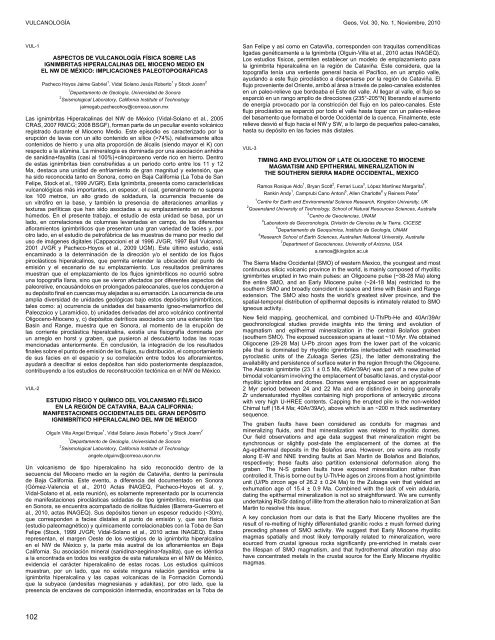
![Libro de resúmenes [revisión final, 172 páginas] - UGM](https://img.yumpu.com/51565067/1/190x245/libro-de-resamenes-revisian-final-172-paginas-ugm.jpg?quality=85)
